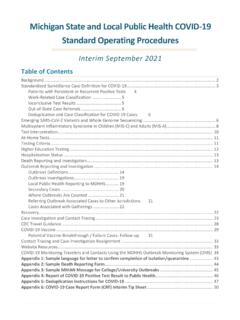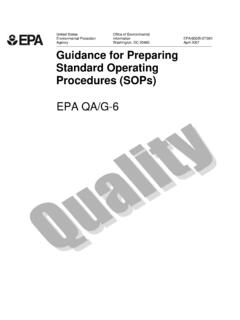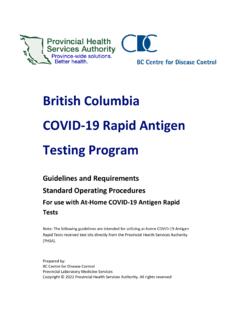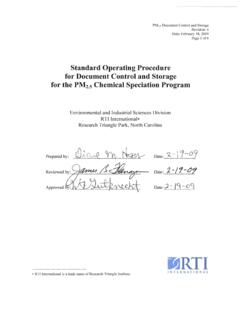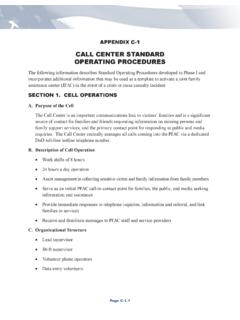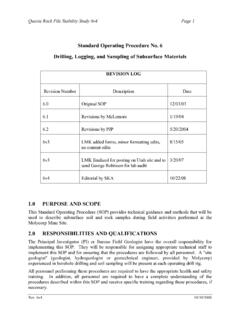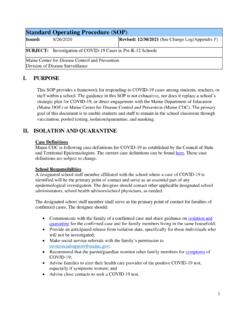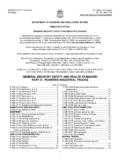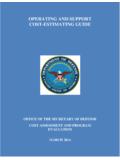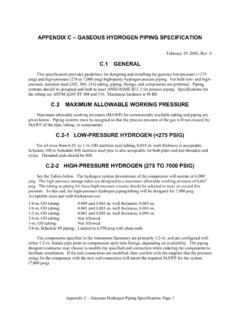Transcription of Standard operating procedure for soil organic carbon ...
1 Standard operating procedure for soil organic carbonWalkley-Black methodTitration and colorimetric methodGlobal Soil Laboratory Network GLOSOLAN GLOSOLAN-SOP-02 SOIL organic carbon WALKLEY-BLACK METHOD: Titration and Colorimetric Method Version number : 1 Page 1 of 25 Effective date : October 28, 2019 Modify by Revision Approval date Validated date GLOSOLAN SOP Tech. Leader: G. Nilo, Philippines 3rd GLOSOLAN meeting 3rd GLOSOLAN meeting 27 October 2019 SOIL organic carbon WALKLEY-BLACK METHOD Titration and Colorimetric Method VERSION HISTORY N Date Description of the modification Type of modification 01 30 July 2019 Finalization of the draft version Compilation of all inputs received by RESOLANs 02 28 October 2019 Final review of the SOP at the 3rd GLOSOLAN meeting Revision of steps in the SOP, final discussion and agreement 03 04 Global Soil Laboratory Network GLOSOLAN GLOSOLAN-SOP-02 SOIL organic carbon WALKLEY-BLACK METHOD: Titration and Colorimetric Method Version number : 1 Page 2 of 25 Effective date : October 28, 2019 Modify by Revision Approval date Validated date GLOSOLAN SOP Tech.
2 Leader: G. Nilo, Philippines 3rd GLOSOLAN meeting 3rd GLOSOLAN meeting 27 October 2019 Contents 1. Brief introduction to soil organic carbon (SOC) .. 3 2. Scope and field of application .. 4 3. Principle .. 5 4. Apparatus .. 6 For Titration Method .. 6 For Colorimetric Method .. 7 5. Materials .. 8 For Titration Method .. 8 For Colorimetric Method .. 9 6. Health and safety .. 10 Personnel safety .. 10 Chemical hazard .. 10 7. Sample preparation .. 10 8. procedure .. 11 Titration Method .. 11 Colorimetric Method .. 13 9. Calculation .. 15 Titration Method .. 15 Colorimetric Method .. 16 10. Quality assurance/Quality control .. 17 Accuracy Test .. 17 Precision Test .. 17 Control Chart .. 18 11. Reference documents .. 19 12. Appendix I. Acknowledgements .. 21 13. Appendix II. List of Authors .. 21 14. Appendix III. Contributing laboratories .. 22 Global Soil Laboratory Network GLOSOLAN GLOSOLAN-SOP-02 SOIL organic carbon WALKLEY-BLACK METHOD: Titration and Colorimetric Method Version number : 1 Page 3 of 25 Effective date : October 28, 2019 Modify by Revision Approval date Validated date GLOSOLAN SOP Tech.
3 Leader: G. Nilo, Philippines 3rd GLOSOLAN meeting 3rd GLOSOLAN meeting 27 October 2019 1. Brief introduction to soil organic carbon (SOC) Soil carbon is probably the most important component in soils as it affects almost all soil properties. carbon , as soil organic matter, alters the physical, chemical, and biological properties of soils. Soil organic matter refers to all decomposed, partly decomposed and undecomposed organic materials of plant and animal origin. It is generally synonymous with humus although the latter is more commonly used when referring to the well decomposed organic matter called humic substances. Soil organic matter is a primary indicator of soil quality. Improvements in soil organic matter create a more favourable soil environment, leading to increases in plant growth. Higher soil organic matter levels cause the soil to retain more water that results in better crop yields, reduces soil erosion, increases plant nutrient retention and increases biological diversity.
4 Moreover, improved aggregation of soil particles results in better soil structure, allowing for movement of air and water through the soil, as well as better root growth. More stable soil structure results in less soil erosion, which retains nutrients on the land and protects water quality. Soil organic carbon contributes to the cation exchange capacity of a soil. These cation exchange sites are important for retention of nutrients such as calcium, magnesium and potassium. Soil organic carbon often also provides binding sites for many anthropogenic organo chemicals, thus minimizing leaching of hazardous chemicals through the soil profile or making them less bioavailable, which reduces toxicity. Increased soil organic carbon enhances the biomass and diversity of the soil biota. Since the soil microbial community drives many of the nutrient transformations in soil, plant nutrient availability is often enhanced with the increase in microbial biomass and microbial activity of the soil.
5 In soil classification, the content of organic carbon of mineral horizons can be estimated from the Munsell colour of a dry and/or moist soil, taking the textural class into account. This estimation is based on the assumption that the soil colour (Munsell value) is due to a mixture of dark coloured organic substances and light coloured minerals. This estimate does not work well in strongly coloured subsoils. It tends to overestimate organic carbon content in soils of dry regions, and to underestimate Global Soil Laboratory Network GLOSOLAN GLOSOLAN-SOP-02 SOIL organic carbon WALKLEY-BLACK METHOD: Titration and Colorimetric Method Version number : 1 Page 4 of 25 Effective date : October 28, 2019 Modify by Revision Approval date Validated date GLOSOLAN SOP Tech. Leader: G. Nilo, Philippines 3rd GLOSOLAN meeting 3rd GLOSOLAN meeting 27 October 2019 the organic carbon content in some tropical soils.
6 Therefore, the inferred organic carbon status of a soil should always be locally checked as it is only a rough estimate. Note for soil classification purposes: (Food and Agriculture Organization of the United Nations, 2006) * organic carbon content of percent mollic and umbric horizon. * organic carbon content of percent voronic horizon. (Note: the ratio of organic carbon to organic matter is about 1 ) In all these situations, it is important to have high quality organic carbon data ( with low uncertainties). Luckily, the methods to measure organic carbon are rather easy to run but a special effort should be made by soil analysis laboratories to provide the best possible quality data. This will allow monitoring of changes in SOC at both local and regional scales and also give a better idea of the future scenarios, not only for SOC content but also for atmospheric CO2 evolution. 2. Scope and field of application This protocol applies to the determination of the Oxidizable organic carbon content in soil.
7 organic carbon content is calculated from the amount of chromic ion (Cr3+) formed, using a titration or colorimetric method, the presence of chloride (> Cl-) will produce a positive interference in saline soils. The bias resulting from the presence of chloride can be corrected if required (Rayment and Lyons, 2011). This method is described in Nelson and Sommers (1996) and the test method described here does not routinely apply correction for chloride. Global Soil Laboratory Network GLOSOLAN GLOSOLAN-SOP-02 SOIL organic carbon WALKLEY-BLACK METHOD: Titration and Colorimetric Method Version number : 1 Page 5 of 25 Effective date : October 28, 2019 Modify by Revision Approval date Validated date GLOSOLAN SOP Tech. Leader: G. Nilo, Philippines 3rd GLOSOLAN meeting 3rd GLOSOLAN meeting 27 October 2019 3. Principle The determination of soil organic carbon is based on the Walkley & Black chromic acid wet oxidation method.
8 Oxidizable organic carbon in the soil is oxidised by M potassium dichromate (K2Cr2O7) solution in concentrated sulfuric acid. The heat of reaction raises the temperature which is sufficient to induce substantial oxidation. Chemical reaction is as follows: The Cr2O72- reduced during the reaction with soil is proportional to the oxidisable organic C present in the sample. The organic carbon can then be estimated by measuring the remaining unreduced dichromate by back-titrating with ferrous sulphate or ammonium ferrous sulphate using diphenylamine or o-phenanthroline-ferrous complex as an indicator. Alternately the organic carbon can be calculated from the amount of chromic ion (Cr3+) formed, using a colorimetric procedure measuring absorbance at 588 nm (after Sims and Haby 1971). An advantage of this procedure over the titrimetric method is that accurate standardisation of the Cr2O72- solution is not required.
9 Points to be noted: 1. Recoveries of the total Soil organic carbon by this method can typically be between 75 90 % in surface soils and will vary with soil type and depth. Walkley & Black found that on the average about 77% of the organic C was recovered by the heat of dilution procedure , and they proposed that a correction factor of be used to account for unrecovered organic C; 2. This method is subject to interferences by certain soil constituents that lead to false results with some soils. Chloride, ferrous iron and higher oxides of Mn have been shown to 2 Cr2O72- + 3 C0 + 16 H+ 4 Cr3+ + 3 CO2 + 8 H2O 6 Fe2+ + Cr2O72- + 14 H+ 2 Cr3+ + 6 Fe3+ + 7 H2O Global Soil Laboratory Network GLOSOLAN GLOSOLAN-SOP-02 SOIL organic carbon WALKLEY-BLACK METHOD: Titration and Colorimetric Method Version number : 1 Page 6 of 25 Effective date : October 28, 2019 Modify by Revision Approval date Validated date GLOSOLAN SOP Tech.
10 Leader: G. Nilo, Philippines 3rd GLOSOLAN meeting 3rd GLOSOLAN meeting 27 October 2019 undergo oxidation-reduction reactions in chromic acid mixtures leading to incorrect values for organic C. The presence of significant amounts of Fe2+ or Cl- in soil will lead to a positive error, whereas reactive MnO2 in soil samples will result in a negative error and low values for organic C. The addition of H3PO4 after the sample has cooled helps eliminate interferences from the ferric (Fe3+) ion that may be present in the sample. Chloride interference can be eliminated by washing the soil free of Cl-1 before analysis or precipitating the Cl-1 as AgCl by addition of Ag2SO4 to the digestion acid; 3. For soils that are very high in organic carbon content, the Walkley & Black method may result in low test results, due to the incomplete oxidation of the organic carbon in the sample.










